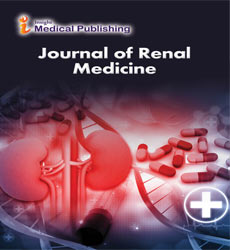Monitoring Glomerular Filtration Rate (GFR) is Important for Managing Kidney Disease
Jorge Robert*
Department of Nephrology, University Hospitals Leuven, Leuven, Belgium
- *Corresponding Author:
- Jorge Robert
Department of Nephrology, University Hospitals Leuven, Leuven,
Belgium,
E-mail: bammens@hotmail.com
Received date: April 09, 2024, Manuscript No. IPJRM-24-19160; Editor assigned date: April 12, 2024, PreQC No. IPJRM-24-19160 (PQ); Reviewed date: April 26, 2024, QC No. IPJRM-24-19160; Revised date: May 03, 2024 , Manuscript No. IPJRM-24-19160 (R); Published date: May 10, 2024, DOI: 10.36648/ipjrm.7.3.24
Citation: Robert J (2024) Monitoring Glomerular Filtration Rate (GFR) is Important for Managing Kidney Disease. Jour Ren Med Vol. 7 No.3: 24.
Description
The Glomerular Filtration Rate (GFR) serves as a cornerstone in the assessment of kidney function and plays a essential role in diagnosing, monitoring, and managing various renal and systemic diseases. Accurate measurement and interpretation of GFR require an understanding of the underlying physiology, factors affecting renal function, and clinical implications in different patient populations. By integrating GFR into clinical practice, healthcare providers can optimize patient care, mitigate complications, and improve outcomes in individuals with kidney and systemic disorders. Continued research and advancements in GFR assessment techniques present prospects for enhancing our understanding of renal physiology and refining strategies for the prevention and treatment of kidney diseases.
Importance of Glomerular Filtration Rate (GRF)
Kidney function assessment Glomerular Filtration Rate (GFR) is considered the best overall indicator of kidney function. It helps in diagnosing and monitoring various kidney diseases, including Chronic Kidney Disease (CKD), Acute Kidney Injury (AKI), and renal insufficiency. Changes in GFR over time can indicate the progression or regression of kidney diseases. It provides valuable information for healthcare providers to adjust treatment strategies accordingly. Many medications are excreted by the kidneys, and their dosages need to be adjusted based on GFR to prevent toxicity or inefficacy. Understanding GFR helps in optimizing drug therapy, especially in patients with impaired kidney function. Reduced GFR is associated with an increased risk of complications such as cardiovascular disease, electrolyte imbalances, and fluid overload. Monitoring GFR aids in identifying high-risk patients who may require intensive management to prevent adverse outcomes. Creatinine, a waste product of muscle metabolism, is commonly used to estimate GFR. Creatinine clearance involves measuring the amount of creatinine cleared from the blood by the kidneys over a specified time period, usually 24 hours. However, this method is cumbersome and less accurate compared to other techniques. Estimated GFR (eGFR) can be calculated using serum creatinine levels and demographic variables such as age, sex, and race. The Modification of Diet in Renal Disease (MDRD) equation and the Chronic Kidney Disease Epidemiology Collaboration (CKD-EPI) equation are widely used to estimate GFR based on creatinine levels. Cystatin C is a protein produced by all nucleated cells at a constant rate and is freely filtered by the glomerulus. Measurement of serum cystatin C levels provides an alternative method for estimating GFR, particularly in situations where creatinine-based equations may be less accurate, such as in elderly individuals or those with altered muscle mass. Nuclear medicine imaging techniques such as technetium-99 m Diethylene Triamine Penta-Acetic Acid (99 mTc-DTPA) or iothalamate are used to directly measure GFR. These methods involve injecting a radioactive tracer and measuring its clearance from the blood by the kidneys. Inulin, a polysaccharide, is considered the Criterion for measuring GFR as it is freely filtered by the glomerulus and neither reabsorbed nor secreted by the renal tubules. However, inulin clearance requires intravenous infusion of inulin, making it impractical for routine clinical use and primarily reserved for research purposes.
Clinical significance of glomerular filtration rate
GFR is categorized into different stages of CKD based on severity, ranging from Stage 1 (normal or high GFR with evidence of kidney damage) to Stage 5 (kidney failure requiring dialysis or transplantation). Monitoring GFR helps in risk stratification, predicting outcomes, and guiding treatment decisions in CKD patients. Decreased GFR is a hallmark feature of AKI, which can occur due to various causes such as hypovolemia, nephrotoxic medications, sepsis, or obstructive uropathy. Timely assessment of GFR aids in diagnosing AKI, monitoring renal function during the acute phase, and predicting recovery. Reduced GFR is independently associated with an increased risk of cardiovascular events such as myocardial infarction, stroke, and heart failure. Monitoring GFR helps in identifying individuals at higher cardiovascular risk who may benefit from aggressive risk factor modification and cardiovascular surveillance. Many medications, particularly those renally excreted, require dosage adjustments based on GFR to avoid toxicity or therapeutic failure. Healthcare providers rely on accurate GFR estimates to optimize drug therapy and minimize adverse effects, especially in vulnerable populations such as the elderly or patients with comorbidities. Preoperative assessment of GFR is essential for evaluating renal function and assessing the risk of perioperative complications, particularly in patients undergoing major surgeries where renal perfusion and function may be compromised. Pregnancy is associated with significant changes in renal hemodynamics, including increased GFR, which peaks in the second trimester. Monitoring GFR during pregnancy helps in identifying gestational hypertension, preeclampsia, or other renal complications that may affect maternal and fetal outcomes.
Open Access Journals
- Aquaculture & Veterinary Science
- Chemistry & Chemical Sciences
- Clinical Sciences
- Engineering
- General Science
- Genetics & Molecular Biology
- Health Care & Nursing
- Immunology & Microbiology
- Materials Science
- Mathematics & Physics
- Medical Sciences
- Neurology & Psychiatry
- Oncology & Cancer Science
- Pharmaceutical Sciences
